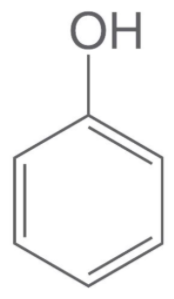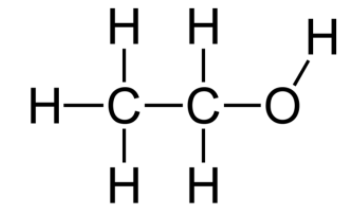Answer
396.3k+ views
Hint: An acid is a molecule or ion that can give a proton (hydrogen ion \[{{\text{H}}^{\text{ + }}}\]) (a Bronsted-Lowry acid), or, alternatively, form a covalent bond with an electron pair (Lewis acid). Acidity is the property, in which a molecule’s ability to lose a proton, is examined. Higher its ability to lose proton higher is the acidity.
Complete answer:
As we know that, Phenol is an organic, aromatic compound with the \[{{\text{C}}_{\text{6}}}{{\text{H}}_{\text{5}}}{\text{OH}}\] molecular formula. It is a volatile, white crystalline solid. The molecule consists of a group of phenyl \[\left( { - {{\text{C}}_{\text{6}}}{{\text{H}}_{\text{5}}}} \right)\] bonded with a group of hydroxyl \[\left( { - {\text{OH}}} \right)\]. Mildly acidic, it requires careful handling because chemical burns can occur.
In chemistry, alcohol is an organic compound which carries at least one functional hydroxyl group \[\left( { - {\text{OH}}} \right)\] attached to a saturated carbon atom.
Structure of phenol:

Structure of alcohol:

While phenols are stronger acids than alcohols, they are still very weak acids. A standard alcohol carries a \[16 - 17\] \[{\text{p}}{{\text{K}}_{\text{a}}}\]. Phenols react to the phenoxide ions with aqueous sodium hydroxide. This means a higher acidity of phenols relative to alcohols. Because of the resonance in the benzene ring, the phenoxide ion is stabilized by the delocalization of negative charge.
In phenol:
\[{\text{PhOH}} \rightleftharpoons {\text{Ph}}{{\text{O}}^ - } + {{\text{H}}^ + }\]
Phenol is about 1 million times more acidic relative to aliphatic alcohols but it is still considered a weak acid. It responds fully to loss of \[{{\text{H}}^{\text{ + }}}\] with aqueous \[{\text{NaOH}}\], giving the salt sodium phenoxide, whereas most alcohols react only partially.
In the case of any alcohol (e.g. \[{\text{C}}{{\text{H}}_{\text{3}}}{\text{OH}}\]), the alkyl group attached to the oxygen atom is by course releasing electrons due to inductive action \[{\text{ + I}}\] effect. This alkyl group character decreases the electronegativity of oxygen and thus decreases its ability to give \[{{\text{H}}^{\text{ + }}}\].
Thus Phenols are more acidic than alcohols due to resonance.
Note: Phenols are much more acidic than alcohols due to negative charge. Acidic compounds are more negatively charged then phenol and only due to this nature they form more anions with the compounds and carry negative charge and those having negative charge they are more acidic in nature.
Complete answer:
As we know that, Phenol is an organic, aromatic compound with the \[{{\text{C}}_{\text{6}}}{{\text{H}}_{\text{5}}}{\text{OH}}\] molecular formula. It is a volatile, white crystalline solid. The molecule consists of a group of phenyl \[\left( { - {{\text{C}}_{\text{6}}}{{\text{H}}_{\text{5}}}} \right)\] bonded with a group of hydroxyl \[\left( { - {\text{OH}}} \right)\]. Mildly acidic, it requires careful handling because chemical burns can occur.
In chemistry, alcohol is an organic compound which carries at least one functional hydroxyl group \[\left( { - {\text{OH}}} \right)\] attached to a saturated carbon atom.
Structure of phenol:

Structure of alcohol:

While phenols are stronger acids than alcohols, they are still very weak acids. A standard alcohol carries a \[16 - 17\] \[{\text{p}}{{\text{K}}_{\text{a}}}\]. Phenols react to the phenoxide ions with aqueous sodium hydroxide. This means a higher acidity of phenols relative to alcohols. Because of the resonance in the benzene ring, the phenoxide ion is stabilized by the delocalization of negative charge.
In phenol:
\[{\text{PhOH}} \rightleftharpoons {\text{Ph}}{{\text{O}}^ - } + {{\text{H}}^ + }\]
Phenol is about 1 million times more acidic relative to aliphatic alcohols but it is still considered a weak acid. It responds fully to loss of \[{{\text{H}}^{\text{ + }}}\] with aqueous \[{\text{NaOH}}\], giving the salt sodium phenoxide, whereas most alcohols react only partially.
In the case of any alcohol (e.g. \[{\text{C}}{{\text{H}}_{\text{3}}}{\text{OH}}\]), the alkyl group attached to the oxygen atom is by course releasing electrons due to inductive action \[{\text{ + I}}\] effect. This alkyl group character decreases the electronegativity of oxygen and thus decreases its ability to give \[{{\text{H}}^{\text{ + }}}\].
Thus Phenols are more acidic than alcohols due to resonance.
Note: Phenols are much more acidic than alcohols due to negative charge. Acidic compounds are more negatively charged then phenol and only due to this nature they form more anions with the compounds and carry negative charge and those having negative charge they are more acidic in nature.
Recently Updated Pages
Basicity of sulphurous acid and sulphuric acid are

Three beakers labelled as A B and C each containing 25 mL of water were taken A small amount of NaOH anhydrous CuSO4 and NaCl were added to the beakers A B and C respectively It was observed that there was an increase in the temperature of the solutions contained in beakers A and B whereas in case of beaker C the temperature of the solution falls Which one of the following statements isarecorrect i In beakers A and B exothermic process has occurred ii In beakers A and B endothermic process has occurred iii In beaker C exothermic process has occurred iv In beaker C endothermic process has occurred

What is the stopping potential when the metal with class 12 physics JEE_Main

The momentum of a photon is 2 times 10 16gm cmsec Its class 12 physics JEE_Main

How do you arrange NH4 + BF3 H2O C2H2 in increasing class 11 chemistry CBSE

Is H mCT and q mCT the same thing If so which is more class 11 chemistry CBSE

Trending doubts
Difference between Prokaryotic cell and Eukaryotic class 11 biology CBSE

Difference Between Plant Cell and Animal Cell

Fill the blanks with the suitable prepositions 1 The class 9 english CBSE

Change the following sentences into negative and interrogative class 10 english CBSE

Give 10 examples for herbs , shrubs , climbers , creepers

What organs are located on the left side of your body class 11 biology CBSE

Write an application to the principal requesting five class 10 english CBSE

What is the type of food and mode of feeding of the class 11 biology CBSE

Name 10 Living and Non living things class 9 biology CBSE



